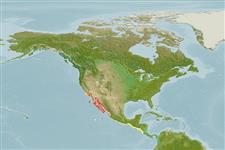Preferred temperature (Ref.
123201): 18.1 - 26.8, mean 22.3 °C (based on 42 cells).
Phylogenetic diversity index (Ref.
82804): PD
50 = 0.5020 [Uniqueness, from 0.5 = low to 2.0 = high].
Bayesian length-weight: a=0.01288 (0.00809 - 0.02051), b=3.00 (2.88 - 3.12), in cm total length, based on LWR estimates for this species & Genus-body shape (Ref.
93245).
Niveau trophique (Ref.
69278): 4.1 ±0.56 se; based on food items.
Generation time: 3.7 ( na - na) years. Estimated as median ln(3)/K based on 1
growth studies.
Résilience (Ref.
120179): Milieu, temps minimum de doublement de population : 1,4 à 4,4 années (tm=1.5; tmax=20; K=0.296).
Fishing Vulnerability (Ref.
59153): Moderate vulnerability (37 of 100).
Nutrients (Ref.
124155): Calcium = 20.5 [11.6, 42.9] mg/100g; Iron = 0.556 [0.279, 0.979] mg/100g; Protein = 19.4 [17.5, 21.0] %; Omega3 = 0.224 [0.132, 0.376] g/100g; Selenium = 16.4 [8.6, 32.5] μg/100g; VitaminA = 73.5 [24.6, 256.6] μg/100g; Zinc = 0.566 [0.368, 0.879] mg/100g (wet weight);
